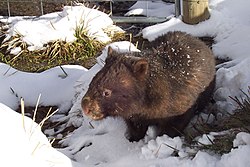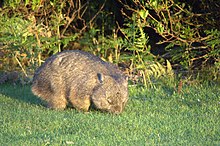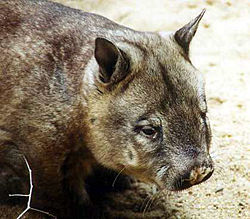Wombat: Difference between revisions
No edit summary |
Revert to revision 134578117 dated 2007-05-30 15:14:56 by UtherSRG using popups |
||
| Line 26: | Line 26: | ||
* †''[[Ramasayia]]''}} |
* †''[[Ramasayia]]''}} |
||
'''Wombats''' are [[Australia]]n [[marsupial]]s; they are short-legged, muscular [[quadruped]]s, approximately one [[ |
'''Wombats''' are [[Australia]]n [[marsupial]]s; they are short-legged, muscular [[quadruped]]s, approximately one [[metre]] (3 [[Foot (unit of length)|feet]]) in length with a very short [[tail]]. The name ''wombat'' comes from the [[Eora]] Aboriginal community who were the original inhabitants of the [[Sydney]] area. Wombats dig extensive burrow systems with rodent-like front teeth and powerful claws. Although mainly [[crepuscular]] and [[nocturnal]], wombats will also venture out to feed on cool or overcast days. They are not as easily seen as many [[animal]]s, but leave ample evidence of their passage, treating fences as a minor inconvenience to be gone through or under and leaving distinctive cubic scats. Wombats are [[herbivore]]s, their [[diet (nutrition)|diet]] consisting mostly of [[Poaceae|grasses]], [[Cyperaceae|sedges]], [[Herb#Botanical definitions|herbs]], [[bark]] and [[root]]s. Their fur color can vary from a sandy color to brown, or from grey to black. |
||
== History == |
== History == |
||
Revision as of 19:51, 30 May 2007
| Wombats | |
|---|---|

| |
| Common Wombat in the snow | |
| Scientific classification | |
| Kingdom: | |
| Phylum: | |
| Class: | |
| Infraclass: | |
| Order: | |
| Suborder: | |
| Family: | Vombatidae Burnett, 1829
|
| Genera and Species | |
Wombats are Australian marsupials; they are short-legged, muscular quadrupeds, approximately one metre (3 feet) in length with a very short tail. The name wombat comes from the Eora Aboriginal community who were the original inhabitants of the Sydney area. Wombats dig extensive burrow systems with rodent-like front teeth and powerful claws. Although mainly crepuscular and nocturnal, wombats will also venture out to feed on cool or overcast days. They are not as easily seen as many animals, but leave ample evidence of their passage, treating fences as a minor inconvenience to be gone through or under and leaving distinctive cubic scats. Wombats are herbivores, their diet consisting mostly of grasses, sedges, herbs, bark and roots. Their fur color can vary from a sandy color to brown, or from grey to black.
History
Wombats, like all the larger living marsupials, are part of the Diprotodontia. The ancestors of modern wombats evolved sometime between 55 and 26 million years ago (no useful fossil record has yet been found for this period) and about 12 species flourished until well into the ice ages. Among the several diprotodon (giant wombat) species was the largest marsupial to have ever lived. The earliest human inhabitants of Australia arrived while diprotodons were still common, and are believed to have brought about their extinction through hunting, habitat alteration, or both.
Ecology and behavior

Wombats have an extraordinarily slow metabolism, taking around 14 days to complete digestion, and generally move slowly. When required, however, they can reach up to 40 km/h and maintain that speed for up to 90 seconds.
When attacked, they can summon immense reserves of strength — one defense of a wombat against a predator (such as a Dingo) underground is to crush it against the roof of the tunnel until the wombat has caused the predator to cease breathing. Its primary defence is its toughened rear hide with most of the posterior made of cartilage which, combined with its lack of a meaningful tail, presents a difficult-to-bite target to any enemy who follows the wombat into its tunnel. One naturalist commented, that a predator biting into a wombat's rear would find it "comparable to the business end of a toilet brush".
Species
There are three species, all around a metre long and weighing between 20 and 35 kg (44 to 77 pounds):
- Common Wombat (Vombatus ursinus)
- Southern Hairy-nosed Wombat (Lasiorhinus latifrons)
- Northern Hairy-nosed Wombat or Yaminon (Lasiorhinus krefftii)
Wombats and humans

They can be awkwardly tamed in a captive situation, and even coaxed to be patted and held. Many parks, zoos and other tourist set-ups across Australia have wombats for show to the public. Wombats are quite popular in the zoos in which they are present.
However, this lack of fear also means that they may display acts of aggression if provoked, or if they are simply in a bad mood. Its sheer weight makes a charging wombat capable of knocking an average-sized man over, and their sharp teeth and powerful jaws can result in severe wounds. The naturalist Harry Frauca once received a bite 2 cm deep into the flesh of his leg—through a rubber boot, trousers and thick woollen socks (Underhill, 1993). A young boy let into an enclosure unprotected to feed a wombat at a caravan park was charged, knocked over, and bitten and scratched all over. [1]
Wombats, while they look cute and cuddly when small, do not make good pets in the long run. They are solitary animals and prefer to stay that way when older.
Unfortunately many people's only contact with wombats is on highways at night, when many are killed in accidents, often doing considerable damage to vehicles.
Wombats in popular culture
Children's author Jackie French's illustrated storybook Diary of a Wombat (2002, ISBN 0-207-19995-7 ) has won numerous awards worldwide. Wombats in fiction and cartoons are often depicted as sluggish, irritable and dimwitted. One such wombat character is the eponymous hero of the author Ruth Park's Muddle Headed Wombat stories.
A hairy-nosed wombat by the name of Glenda appears in the books "The Terrible Underpants" and "Wanda-Linda goes Berserk" by Kaz Cooke. In afterwords, the books promote an awareness of wombats and the threats they face. It is not made clear if Glenda is a Southern or Northern Hairy-nosed wombat.
The RSPCA of Australia ran a prominent television advertisement in which injured animals would run across the screen to classical music. A small injured wombat would repeatedly start to cross the screen, but then turn around and run back, at the end of the advertisement, it would quickly run across the screen. This, coupled with wombats' generally retiring nature when viewed during the day at zoos, has led to the popular misconception that wombats are timid and shy creatures.
The webcomic Digger by Ursula Vernon stars a lovable, feisty young wombat, lost far from home after tunnelling into unknown magic.
The long-running webcomic Penny Arcade contains many references to wombats, such as the Necrowombicon and the use of a wombat head as their page icon.
In a short humorous poem by Ogden Nash, the speaker finds wombats rather enigmatic, but asserts that he "would not engage the wombat in any form of mortal combat."
"Fatso" the pet wombat was a popular character on the television show A Country Practice.
A fictional wombat also called "Fatso" was created by comedians Roy and HG as an unofficial mascot of the 2000 Summer Olympics.
Wombat! was a children's television show on the Seven Network in the late 1980s.
The Southern Hairy-nosed Wombat (L. latifrons) is the official faunal emblem of the state of South Australia.
Further reading
- The Death of a Wombat, Ivan Smith, drawings by Clifton Pugh, Charles Scribner's Sons, 1973, hardcover, 62 pages, ISBN 0-684-13538-8. A humble wombat meets a tragic end during a fire.
- Wombats, Barbara Triggs, Houghton Mifflin Australia Pty, 1990, ISBN 0-86770-114-5. Facts and photographs of wombats for children.
- The Wombat: Common Wombats in Australia, Barbara Triggs, University of New South Wales Press, 1996, ISBN 0-86840-263-X.
- The Secret Life of Wombats, James Woodford, Text Publishing, 2002, ISBN 1-877008-43-5.
References
- Groves, C. P. (2005). Wilson, D. E.; Reeder, D. M. (eds.). Mammal Species of the World: A Taxonomic and Geographic Reference (3rd ed.). Baltimore: Johns Hopkins University Press. pp. 43–44. ISBN 0-801-88221-4. OCLC 62265494.
